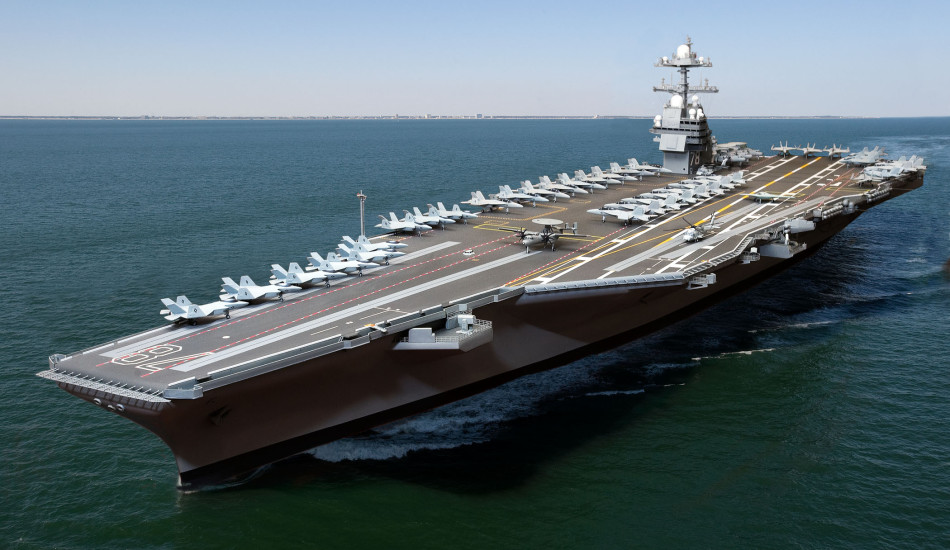(NationalSecurity.news) The U.S. Navy’s carrier strike groups must adapt to a host of emerging long-range threats or face the greatest risks of destruction since World War II, a number of experts testified before federal lawmakers last week.
As reported by Navy Times, the experts also provided insight into what the future fleet ought to look like, as rising threats from global powers like Russia and regional foes like China and Iran continue to evolve.
“The risk to U.S. aircraft carriers is arguably as large as it’s ever been since our carriers were actually out there fighting in the Second World War,” Michael Horowitz, a political science professor at the University of Pennsylvania, told members of the House Armed Services Committee’s subcommittee on seapower.
Seth Cropsey, director of the Center for American Seapower at the Hudson Institute, and Naval War College professor emeritus Robert Rubel joined Horowitz as part of a panel addressing the subcommittee. The experts testified as budget season begins on Capitol Hill.
Overall, the Navy needs to reassess how it will use its aircraft carriers in the coming years in theaters were adversaries are likely to be armed with multiple long-range weapons systems, especially missiles. That might mean smaller carriers with multiple unmanned airframes for strike missions, dogfighting and refueling, with up to 16 carrier strike groups in all.
“This will be a difficult process for a Navy that has become accustomed to being unchallenged for the past 25 years,” Rubel said, the Times reported.
Cropsey told the panel that the Navy would be better off with a broad diversity of options regarding the carriers themselves and their air wings. That may mean adding some smaller carriers to the fleet and multiple strike capabilities to deal with high-end and low-end threats. He said the F-35C, for instance, is far and away more capability than is needed for missions like targeting an Islamic State convoy.
“I don’t think that if the danger that you face on a camping trip is a grizzly bear, that you should bring a 500-mm Howitzer along with you,” he said. “You can protect yourself with less.”
Rubel agreed, suggesting that cruisers, destroyers and amphibious ships could also provide a good modicum of both presence and deterrence.
“If we don’t have enough carriers to do it, we have to do it with something else,” he said. “We might as well develop something that allows us to take the pressure off the carrier force.”
However, the experts agreed that given the Navy’s slow procurement process the fleet might be stuck with larger carriers and F-35C’s as other platforms and ships are developed, purchased and built.
“My concern is that I’m not sure that we have a choice given the current procurement plans of the Navy,” Rubel said. “The F-35 is perhaps the only game in town for those types of missions.”
China is said to be developing a “carrier killer” ballistic missile – the DF-21D, touted as a Mach 10 monster that is capable of striking a moving ship at sea, not an easy feat. Other experts say that China does not yet possess the technical capability to target moving ships.
Robert Farley, writing for The National Interest in September 2014, discussed the complicated nature of striking a warship at sea, even one as large as a U.S. carrier:
An anti-ship ballistic missile is more than just a missile; it requires a broad, sophisticated support system. Unlike a missile launched at static targets, a carrier-killing ASBM [anti-ship ballistic missile] requires terminal guidance, as it must revise its flight path after reentering the atmosphere. From launch to strike, the flight of an ASBM can take fifteen or so minutes, at which time the carrier in question will have more than likely moved its position on the open ocean. The missile thus needs to be adjusted remotely or needs to have the capacity to identify the carrier on its own. Both of these processes depend on the operation of a sophisticated set of sensors, as well as a communication system capable of integrating these sensors and transmitting information to shooters.
Other experts agree the feat is not so simple. Still, China’s anti-access/area denial (A2/AD) capability from shore is formidable, and it’s growing submarine fleet means approach for U.S. carriers in the South China Sea and the Pacific will be increasing more difficult. China’s aim would be to keep U.S. Navy ships at bay in any conflict, such as an invasion of Taiwan, for instance, or war with Japan.
Richard Fisher, a China expert at the U.S.-based International Assessment and Strategy Center, pointed to another anti-ship missile recently deployed by China: a supersonic air-launched cruise missile carried by the H-6K bomber.
“You begin to see that decades of Chinese military investment are resulting in capabilities that are changing the balance of power in Asia against the United States,” he told the Financial Times.
See also:
NationalSecurity.news is part of the USA Features Media network of sites.


